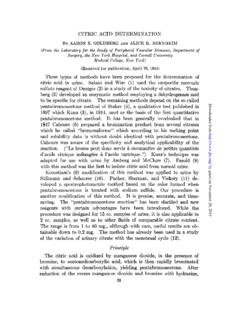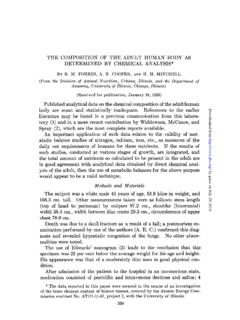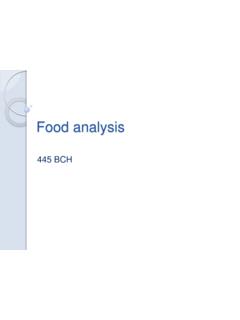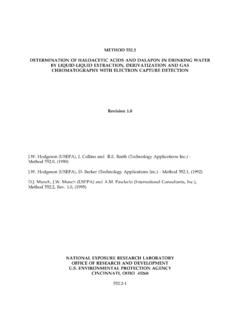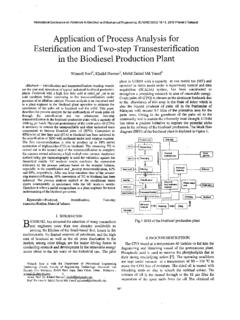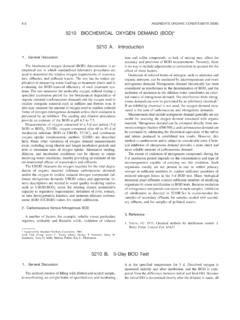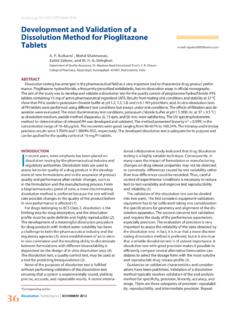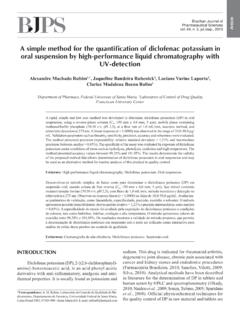Transcription of DETERMINATION OF LIPASE ACTIVITY - The …
1 DETERMINATION OF LIPASE ACTIVITY BY REGINALD M. ARCHIBALD WITH THE TECHNICAL ASSISTANCE OF P. ORTIZ (From the Hospital of The Rockefeller Institute for Medical Research, New York) (Received for publication, June 29, 1946) Heretofore most methods for the DETERMINATION of LIPASE ACTIVITY have employed emulsions of fatty acid esters in water (1). These emulsions have been stabilized by use of such agents as gum acacia. The disad- vantages of such methods are that (1) the emulsions break up to a con- siderable and variable extent during the course of the incubation, and (2) the enzyme is presumed to be in the aqueous phase, whereas the substrate is only dispersed (not in solution) in the aqueous phase. Attempts to study the relation of substrate concentration to rate of hydrolysis are com- plicated by the fact that the substrate and enzyme are in different phases. The rate of hydrolysis in these cases is dependent partly on the degree of dispersion of the substrate rather than on its concentration.
2 Some of the commercially available esters of sorbitan and fatty acids are completely soluble in water. Use of solutions of these esters permits one to study the effect of substrate concentration on enzyme ACTIVITY and eliminates the complications which attend the use of emulsions. Gomori (2) has employed esters with the trade names Tween 40 and Tween 601 as substrates to detect, and to localize histologically, LIPASE ACTIVITY in sections of tissue. This paper outlines a method of measuring quantita- tively LIPASE ACTIVITY in which an aqueous solution of a polyoxyalkylene derivative of sorbitan monolaurate is used as substrate. For convenience this substrate will be designated hereafter by its trade name, Tween 20. Apparatus- Burette, 10 cc. It is convenient to employ a burette connected with a reservoir for NaOH. Both burette and reservoir should be fitted with soda lime tubes to protect the NaOH from atmospheric COZ.
3 30 cc. glass-stoppered bottles (Pyrex) or 30 cc. heavy walled test-tubes with footed stirring rods 2 inches longer than the test-tubes. 1 Tweens and Spans are obtained from the Atlas Powder Company, Wilmington 99, Delaware. Tween 20, a clear yellow liquid, is a mixture of polyoxyalkylene derivatives of an ester of 1 mole of fatty acid per mole of sorbitan. Although the Tween contains more than one ester, the composition of different batches is so uni- form that activities, as determined three different lots, were identical. Tween and Span are registered United States trade marks. 443 by guest on January 4, 2019 from 444 LIPASH ACTIVITY Reagents- Syrupy phosphoric acid. NaH2P04. i&O. ~-l~ethyl-~, Ether Mixture A, 1 part of diethyl ether and 2 parts of petroleum ether. Ether Mixture B, 5 parts of diethyl ether and 1 part of petroleum ether. Phosphate bu$er, M, pH N NaOH solution.
4 Solution of Tween 20, 50 per cent (by volume) solution of the fatty acid-free Tween in water titrated to pH with 18 N NaOH. This should be prepared fresh daily. Removal of Free Fatty Acid from Tween-30 cc. of Tween 201 and 50 cc. of the ether Mixture A are placed in a 100 cc. glass-stoppered bottle; cc. of H3P04 is added. The mixture is shaken vigorously by hand for 15 seconds, then centrifuged (in the stoppered bottle). With the aid of a vacuum line or water vacuum pump the supernatant ether layer containing the fatty acid is removed through a capillary. Another 25 cc. of ether Mixture A are added and the shaking, centrifugation, and with- drawal of supernatant are repeated. The ether dissolved in the Tween layer is then removed by applying a partial vacuum. The Tween from which the free fatty acids have been removed is adjusted to pH with NaOH, then decanted from the subnatant crystals of sodium phosphate.
5 Alternative Method of Removing Fatty Acids-30 cc. of Tween 20 and cc. of syrupy phosphoric acid are placed in a Kutscher-Steudel (3) extractor and extracted for 4 hours with Mixture A. Nearly all of the fatty acid and a small amount of an almost colorless fraction of Tween are extracted by the ether mixture. The residual Tween is then neutralized with 18 N NaOH (about cc.) and the dissolved ether is removed under reduced pressure. Preparation of LIPASE Solution-The LIPASE preparation should be freshly diluted with water so that 1 cc. will liberate between and mM of fatty acid per hour; cc. of a 1 per cent suspension of commerciai pancreatic LIPASE liberates about mM per hour at 25 . Procedure with Glass-Stoppered Bottles3 cc. of 50 per cent solution of neutralized Tween 20, cc. of phosphate buffer, and cc. of LIPASE solu- tion are mixed in a 30 cc.
6 Glass-stoppered Pyrex bottle and allowed to react for 1 hour at 25 . As a control, in a second bottle, another portion of the neutralized Tween 20 solution is set up simultaneously with buffer but without LIPASE . LIPASE solution for the control is allowed to stand in a separate container, and added to the control solution later. At the 2 2-Methyl-2,4-pentanediol is obtained from the Commercial Solvents Corporation. by guest on January 4, 2019 from R. M. ARCHIBALD 445 end of the reaction period, gm. of solid NaH, and 15 cc. of the ether Mixture B are added to each. After mixing the solid phosphate with the solutions, cc. of LIPASE solution is added to the control. Both bottles are stoppered and shaken vigorously for 30 seconds, then cen- trifuged. With the aid of suction and a fine capillary the subnatant aqueous solution of phosphate and the intermediate layer of Tween are removed from each bottle.
7 By tilting the bottles all but a drop or two of Tween can be removed without loss of ether. The ether is then readily decanted into clean 25 cc. beakers. Each bottle is rinsed twice with 3 cc. portions of the ether mixture and the washings are added to the cor- responding beakers. A cc. portion of 2-methyl-2,4-pentanediol is added to each beaker and the ether is evaporated by placing the beaker on a warm surface. The diol keeps the fatty acid in solution. 1 drop of t,hymol blue is added to each residue and the acid is titrated with N NaOH. If ethyl alcohol is used to replace the diol, the color at the end-point is transient, owing presumably to oxidation of alcohol to acetic acid. Alternative Procedure with Test-Tubes for Incubation and Extraction- Incubation and extraction can be conducted in test-tubes almost as readily as in glass-stoppered bottles. When test-tubes are employed, the pro- cedure is exactly as outlined above except that the ether and aqueous phases are mixed by the rapid up and down motion of a footed stirring rod.
8 The layers can be mixed thoroughly and easily without loss of fluid pro- vided the foot of the rod is kept below the upper surface of the ether phase during the mixing. After 4 minutes mixing the rod is removed and the tube is capped and centrifuged (4000 ) for 5 minutes. Calculation-The milliequivalents of acid split off per hour = (D - C)/ (100 X T) where D = the cc. of N NaOH required to titrate the acid extracted from the digest, C = the cc. of NaOH required by the control, and T = the duration of the incubation in hours. Discussion of Method A polyoxyalkylene derivative of a sorbitan lauric acid ester was selected as a substrate in preference to an ester of other acids, because it is com- pletely soluble in water. Furthermore, lauric acid esters are said to be split by pancreatic LIPASE more readily than esters of other acids (( 1)) p. 70) .3 Although triglycerides are said to be more rapidly hydrolyzed than di- or monoglycerides, the polyoxyalkylene sorbitan monolaurate was em- ployed because of its complete solubility in water.
9 Tween 20, in the absence of water, is soluble in diethyl ether, but in- 3 Approximately 60 per cent of the fatty acid in Tween 20 is lauric acid. by guest on January 4, 2019 from 446 LIPASE ACTIVITY .14 .13- .12 - Al- .Ol - I I I I 1 t I 10 20 30 40 50 60 70 Cc. of Tween pep 100 cc. of digestion mixture FIQ. 1. Curve showing the relation of enzyme ACTIVITY at 25 and pH to the concentration of Tween 20 in the reaction mixtures; cc. of 2 per cent pancreatic LIPASE was added to cc. of the mixture of Tween and buffer. 3 pH of reaction mixtue FIG. 2. Curve showing the relation of enzyme ACTIVITY at 25 to pH. cc. aliquots of a 1 per cent pancreatic LIPASE were added to mixtures of cc. of buffer and 3 cc. of 50 per cent Tween 20. soluble in petroleum ether. If higher concentrations of petroleum ether are employed in place of Mixture A, the free fatty acid would be removed less completely.
10 Higher concentrations of ethyl ether would result in by guest on January 4, 2019 from It. M. AECHIBALD 447 the extraction of too much Tween. In the presence of water the Tween is much less soluble in ethyl ether. Hence a larger ratio of ethyl ether is cj .05 E .w4 a I I I x 0 A IO 1: io A 550 35 40 45 Tempecatupe 72. FIQ. 3. Curve showing the effect of temperature on the amount of acid liberated from Tween by pancreatic !ipase. Except for temperature the conditions were as outlined in the procedure for DETERMINATION of LIPASE ACTIVITY . WJ. of commetial pTepaMtion of pancreatic LIPASE FIG. 4. Curve showing the relation of the amount of enzyme present to the amount of aeid liberated from the substrate in 1 hour. The substrate concentration is per cent. used in Mixture B. If the ratio of petroleum ether is increased much over that recommended for Mixture B, difficulty will be experienced in ob- by guest on January 4, 2019 from 448 LIPASE ACTIVITY taining clear supernatant solutions.
